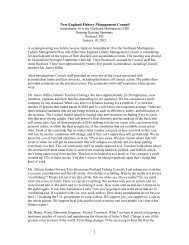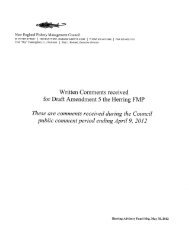Correspondence/Amendment 5 Comments - New England Fishery ...
Correspondence/Amendment 5 Comments - New England Fishery ...
Correspondence/Amendment 5 Comments - New England Fishery ...
Create successful ePaper yourself
Turn your PDF publications into a flip-book with our unique Google optimized e-Paper software.
IJI-SFJVII']R.<br />
Viewpoint article<br />
Fisheries Research 108 (201 I ) 1 -8<br />
Contents lists available at Sc¡enc€D¡rect<br />
Fisheries Research<br />
jou rna I homepage: www.elsevier,com/locate/fish res<br />
The importance of including predation in fish population models:<br />
Implications for biological reference points<br />
M.C. Tyrrell 1, J.S. Link*, H. Moustahfid2<br />
NOAA Natíonal Mañne Físheries Se^)ice, Northeast Ftsheries Science Center, 166 Water St,, Woods Hole, MA 02543 USA<br />
ARTICLE INFO ABSTRACT<br />
Art¡cle history:<br />
Received 2 November 2010<br />
Received in revised form<br />
1 6 December 2010<br />
Accepted 17 December 2010<br />
Keywords:<br />
Multispecies models<br />
Ecosystem models<br />
Forage species<br />
Predation<br />
Mortality<br />
Recruitment<br />
stock assessment<br />
Biologícal reference points<br />
l. Introduction<br />
Continued anthropogenic impacts have led to calls for a more<br />
holistic approach to marine resource management (tarkin, 1996;<br />
Micheli, 1999; Garcia et al., 2003; Browman and Stergiou, 2004).<br />
Several recent high profile papers have indicated globally serious<br />
situations for many marine species, in effect calling for more ecological<br />
factors to be considered (e.g.,Jackson et al., 2001 ; Pauly et al.,<br />
2002; Myers and Worm, 2003; Pikitch et al., 2004; Worm et al.,<br />
2009). Admittedly these observations have not been without their<br />
critics and caveats (e.g., Hilbom,2006). Regardless, there remains a<br />
recognized need to examine marine resource management from<br />
a more holistic, ecosystem-based perspective (Constable, 2001;<br />
Walters et al., 2005; tink, 2010). Central to this ecosystem-based<br />
perspective is accounting for all factors that can influence a fisheries<br />
stock, including ecological interactions.<br />
There have been calls for fisheries managers to account for<br />
species interactions in fish population assessments for at least<br />
several decades (e.g., May et al., 1979) yet incorporating basic<br />
ecological processes (such as predation) into fisheries stock assess-<br />
* Corresponding author. Tel.: +1 5O8 495 234Oi fax: +1 508 495 2258.<br />
E-mail address: ldson,Link@noaa.gov (1.s. Link).<br />
1 Current address: National Park Service, Cape Cod National Seashore,99 Marconí<br />
Site Road, Wellfleet, MA 02667, USA.<br />
2 Current address: NOAA National Ocean Service, Integrated Ocean Observing<br />
System Program, 1315 East-West Highway, Silver Spring, MD 20910, USA.<br />
0165-7836/$ - see front matter. Published by Elsevier B.V.<br />
doi:10.1 0l 6/j.ñshres.20 10. I 2.025<br />
A suite ofapplications utilizing various fisheries models have demonstrated that natural mortality due to<br />
predation is: (1 ) temporally and ontogenetically variable and (2) especially for forage species, generally<br />
higher than assumed in traditional single species stock assessments. Here we demonstrate that biological<br />
reference points generated by explicitly incorporating predation mortality into population dynamic<br />
models are generally more conservative (e.g., recommend higher standing biomass) than those produced<br />
using traditional assessment methods. Because biological reference points are the benchmark against<br />
which fisheries management decisions are made, they should reflect the ecological realities faced by each<br />
species to the fullest extent possible. We suggest much broader consideration of the more conservative<br />
biological reference points produced by explicitly incorporating predation mortality as a component of<br />
natural mortality to population models. This approach could implement a powerful yet tractable facet<br />
of ecosystem based fisheries management and is especially important for those stocks where predation<br />
mortality is known or suspected to be important.<br />
Published by Elsevier B.V.<br />
ments is still uncommon (Link, 2002; Towensend et al., 2008).<br />
Implementing a precautionary, ecosystem-based approach to fisheries<br />
management (EBFM) is becoming increasingly advisable for<br />
the sustainable harvest of marine capture fisheries (Botsford et al.,<br />
1997; Pauly et al., 2002; Carcia et al., 2003; Jennings, 2004). The<br />
accumulation ofnovel approaches to account for ecological interactions<br />
in fisheries models (e.g., Hollowed et al., 2000; Whipple et al.,<br />
2000; Hvingel and Kingsley, 2006), which have recently begun to<br />
be extensively reviewed (Plaganyi, 2007; Towensend et al., 2008),<br />
veriff that the tools to do so are extant.<br />
Forage species are a particularly germane instance where such<br />
ecological interactions should be given due consideration. Such<br />
species usually occupy middle trophic levels, serve as a mechanism<br />
of converting lower trophic level energy or biomass into forms<br />
suitable for upper trophic level consumption, are common prey for<br />
a wide range of such upper trophic level species, and can be an<br />
important source of standing biomass in an ecosystem. As such,<br />
forage species-which are often subject to both predation pressure<br />
and to commercial harvesting-are a logical starting point for<br />
demonstrating the efficacy of incorporating predation into fisheries<br />
population dynamics models. Various authors have found that<br />
when consumption of a particular forage species is calculated, the<br />
predation mortality values that had been assumed as a part of the<br />
total natural mortality in traditional stock assessments were underestimates<br />
(e.g., ICES, 1997; Hollowed et al.,2000; NEFSC,2006) and,<br />
unsurprisingly, that predation mortality is temporally and ontogenetically<br />
variable (e.g., Gislason and Helgason, 1985; Mohn and







